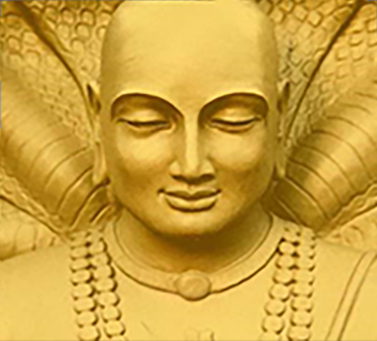
Patanjali is a name that is attributed to several Sanskrit works, but every one is not necessarily the same person. However, perhaps the most notable Patanjali is the attributed author of the Yoga Sutra. This particular Patanjali has been deified by many different groups and he is often depicted as an incarnation or half-bodied version of a mythical snake. Although there is some debate about Patanjali as an author and what texts should be appropriately attributed to him, the most common Patanjali as the creator of the Yoga Stura has a wonderful origin story:
One day, Shiva came upon Vishnu who was sitting on a snake and decided to do a dance for him. Vishnu loved Shiva’s dance immensely and the snake upon which Vishnu sat wanted to learn how to dance in order to make Vishnu that happy. Vishnu told the snake that someday he could become human and learn to dance so the snake began to look for the perfect mother. He found an experienced yoga teacher named Gonika who prayed and prayed for a son. While she prayed, the snake appeared in her hands and transformed into a baby boy, making for not only a fascinating origin story but also the tale of the easiest and least painful birth ever. Gonika then named the child Patanjali, which translates to “pata” meaning “fallen” and “anjali” referring to the palms folded in prayer.
Subsequently, Patanjali is often depicted as having the torso and head of a man and the lower half of a serpent. The serpent is a particularly powerful animal in representation because it is a symbol for reserved energy—one does not know the snake is there until it moves. This symbolism is particularly represented in kundalini yoga because of the focus on circular, continuous, reserved energy.
The Yoga Sutra, created around 400 CE, is a collection of the best, or royal, yoga practices. At the time Patanjali took it upon himself to create this text because there was so much about yoga and its practices that were left to misunderstanding an confusion. The collecting of these aphorisms about yoga is primarily what has led Patanjali to be referred to as the “father of modern yoga”. The Yoga Sutra is the foundational text of ashtanga yoga and at the core is the presentation of the eight limbs of yoga:
Yama: universal morality
Niyama: personal observances
Asanas: poses
Pranayama: controlled breathing
Pratyahara: control of the senses
Dharana: concentration and cultivation of inner awareness
Dhyana: meditaion
Samadhi: union with the Divine
These eight limbs provide the structural framework for yoga practice. Although they are laid out in a list, none of the eight limbs are more important than the others. Additionally, the Yoga Sutra has a focus on a central thought with not mental wandering. This is cultivated in many ways but the best example in modern yoga practices is in meditation and shavasana.
Patanjali, although referenced as the author of many texts including Mahabhasya and an unspecified work of medicine (ayurveda), is most commonly spoken of in reference to the Yoga Sutra. This common compilation of yoga practice, instruction, and thought has provided the foundation for modern yoga and continues to drive the practices of yogis everywhere. yogatime.tv/blog/patanjali/